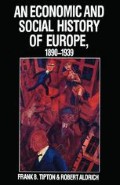Abstract
Through the interwar years European nations continued to be linked to each other by the international economy, and with the rest of the world by the twin bonds of economic exchange and political domination. However, the war had accelerated changes and aggravated the strains in the international economy already visible before 1914. Two new powers, the United States and Japan, had emerged into the world economy, and a new aggressive nationalism began to appear in the Middle East, Africa, Asia and Latin America. Together these factors undermined Europe’s attempt to re-establish the prewar system. The resulting instability contributed to the collapse and depression of the 1930s — which led in turn to a further weakening of Europe’s position. Europe’s role in the world had already been considerably reduced — relatively in the economic sphere, absolutely in the harsher political arena — before the new and greater war.
Preview
Unable to display preview. Download preview PDF.
Author information
Authors and Affiliations
Copyright information
© 1987 Frank B. Tipton and Robert Aldrich
About this chapter
Cite this chapter
Tipton, F.B., Aldrich, R. (1987). Europe and the World between the Wars. In: An Economic and Social History of Europe, 1890–1939. Palgrave, London. https://doi.org/10.1007/978-1-349-18901-4_8
Download citation
DOI: https://doi.org/10.1007/978-1-349-18901-4_8
Publisher Name: Palgrave, London
Print ISBN: 978-0-333-36807-7
Online ISBN: 978-1-349-18901-4
eBook Packages: Palgrave History CollectionHistory (R0)

